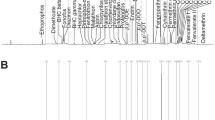Abstract
Ochratoxin A (OTA), a mycotoxin classified as a potentially carcinogenic to humans, is slightly soluble in water. In this study, the transfer rate of OTA in herbal medicines to decoctions was investigated. Herbal medicine decoctions were prepared by boiling and autoclaving herbal medicines contaminated with OTA after soaking and not soaking in water. OTA amounts in decoctions and residues were analyzed using HPLC. Transfer of OTA (12.72–61.33%) from herbal medicines to decoctions was observed. Soaking and autoclaving steps enhanced the transfer rate of OTA to decoctions. The results meant that there is a potential risk for consumption of herbal medicine decoctions. Therefore, regular monitoring for mycotoxins, including OTA, in herbal medicines and proper management to ensure the safety of herbal medicines is necessary to protect consumers.
Similar content being viewed by others
References
Xue J, Liu D, Chen S, Liao Y, Zou Z. Overview on external contamination source in traditional chinese medicines. Mode Tradit. Chin. Med. Mater. Med. 10: 91–96 (2008)
Hitokoto H, Morozumi S, Wauke T, Sakai S, Kurata H. Fungal contamination and mycotoxin detection of powdered herbal drugs. Appl. Environ. Microbiol. 36: 252–256 (1978)
Roy AK, Sinha KK, Chourasia HK. Aflatoxin contamination of some drug plants. Appl. Environ. Microbiol. 54: 842–843 (1988)
Roy AK, Chourasia HK. Mycoflora, mycotoxin producibility, and mycotoxins in traditional herbal drugs from India. J. Gen. Appl. Microbiol. 36: 295–302 (1990)
Horie Y, Yamazaki M, Mitake S. On the toxigenic fungi contaminating herbal drugs. II Floral and mycotoxicological survey of fungi in herbal drugs as raw materials in pharmaceutical industries. Trans. Mycol. Soc. Jpn. 23: 435–447 (1982)
Narita N, Suzuki M, Udagawa S, Sekita S, Harada M, Aoki N, Tanaka T, Hasegawa A, Yamamoto S, Toyazaki N, Matsuda Y. Aflatoxigenic potential of Aspergillus flavus isolates from Indonesian herbal drugs. Proc. Jpn. Assoc. Mycotoxicol. 27: 21–26 (1988)
Tanaka T. Hasegawa A, Yamamoto S. Aoki N, Toyazaki N, Matsuda Y, Udagawa S, Sekita S, Narita N, Suzuki M, Harada M. Natural occurrence of aflatoxins in traditional herbal drugs from Indonesia. Proc. Jpn. Assoc. Mycotoxicol. 28: 33–35 (1988)
Efuntoye MO. Mycotoxins of fungal strains from stored herbal plants and mycotoxin contents of Nigerian crude herbal drugs. Mycopathologia 147: 43–48 (1999)
Shim W-B, Kim K, Ofori JA, Chung Y-C, Chung D-H. Occurrence of aflatoxins in herbal medicine distributed in South Korea. J. Food Prot. 75: 1991–1999 (2012)
Ali N, Hashim NH, Saad B, Safan K, Nakajima M, Yoshizawa T. Evaluation of a method to determine the natural occurrence of aflatoxins in commercial traditional herbal medicines from Malaysia and Indonesia. Food Chem. Toxicol. 43: 1763–1772 (2005)
Ventura M, Gomez A, Anaya I, Diaz J, Broto F, Agut M, Comellas L. Determination of aflatoxin B1, B2, G1, and G2 in medicinal herbs by liquid chromatography-tandem mass spectrometry. J. Chromatogr. A 1048: 25–29 (2004)
Arino A, Herrera M, Estopanan G, Juan T. High levels of ochratoxin A in licorice and derived products. Int. J. Food Microbiol. 114: 366–369 (2007)
Han Z, Zheng Y, Luan L, Ren Y, Wu Y. Analysis of ochratoxin A and ochratoxin B in traditional Chinese medicines by ultra-highperformance liquid chromatography-tandem mass spectrometry using [(13)C(20)]-ochratoxin A as an internal standard. J. Chromatogr. A 1217: 4365–4374 (2010)
Rizzo I, Vedoya G, Maurutto S, Haidukowski M, Varsavsky E. Assessment of toxigenic fungi on Argentinean medicinal herbs. Microbiol. Res. 159: 113–120 (2004)
Trucksess M, Weaver C, Oles C, D’Ovidio K, Rader J. Determination of aflatoxins and ochratoxin A in ginseng and other botanical roots by immunoaffinity column cleanup and liquid chromatography with fluorescence detection. J. AOAC Int. 89: 624–630 (2006)
Yang L, Wang L, Pan J, Xiang L, Yang M, Logrieco AF. Determination of ochratoxin A in traditional Chinese medicinal plants by HPLC-FLD. Food Addit. Contam. A 27: 989–997 (2010)
Esteban A, Abarca ML, Bragulat MR, Cabañes FJ. Effect of water activity on ochratoxin A production by Aspergillus niger aggregate species. Int. J. Food Microbiol. 108: 188–195 (2006)
Patela S, Hazela CM, Wintertona AGM, Mortbyb E. Survey of ethnic foods for mycotoxins. Food Addit. Contam. 13: 833–841 (1996)
IARC Working Group on the Evaluation of Carcinogenic Risks to Humans. World Health Organization. International Agency for Research on Cancer. Man-made Vitreous Fibres. International Agency for Research on Cancer, World Health Organization, Lyon, France (2002)
Trucksess MW, Scott PM. Mycotoxins in botanicals and dried fruits: A review. Food Addit. Contam. A 25: 181–192 (2008)
Araguas C, Gonzalez-Penas E, Lopez de Cerain A. Study on ochratoxin A in cereal-derived products from Spain. Food Chem. 92: 459–464 (2005)
Blesa J, Berrada H, Soriano J, Molto J, Danes J. Rapid determination of ochratoxin A in cereals and cereal products by liquid chromatography. J. Chromatogr. A 1046: 127–131 (2004)
Gonzalez L, Juan C, Soriano JM, Molto JC, Manes J. Occurrence and daily intake of ochratoxin A of organic and non-organic rice and rice products. Int. J. Food Microbiol. 41: 123–158 (2005)
Bokhari FM, Aly MM. Evolution of traditional means of roasting and mycotoxins contaminated coffee beans in Saudi Arabia. Adv. Biol. Res. 3: 71–78 (2009)
Tsubouchi H, Yamamoto K, Hisada K, Sakabe Y, Udagawa S. Effect of roasting on ochratoxin A level in green coffee beans inoculated with Aspergillus ochraceus. Mycopathologia 97: 111–115 (1987)
Commission directive 2002/27/EC of 13 March 2002 amending directive 98/53/EC laying down the sampling methods and the methods of analysis for the official control of the levels for certain contaminants in foodstuffs. European Commission. Off. J. Eur. Commun. L75: 44–45 (2006)
Korea Food and Drug Administration. The Pharmaceutical Affairs Law. Legal permission limit and analytical method for aflatoxins in herbal medicine. pp. 51–52. In: Food Code. Korea Food and Drug Administration, Seoul, Korea (2009)
Author information
Authors and Affiliations
Corresponding author
Rights and permissions
About this article
Cite this article
Shim, WB., Ha, KS., Kim, MG. et al. Evaluation of the transfer rate of ochratoxin a to decoctions of herbal medicines. Food Sci Biotechnol 23, 2103–2108 (2014). https://doi.org/10.1007/s10068-014-0286-y
Received:
Revised:
Accepted:
Published:
Issue Date:
DOI: https://doi.org/10.1007/s10068-014-0286-y



